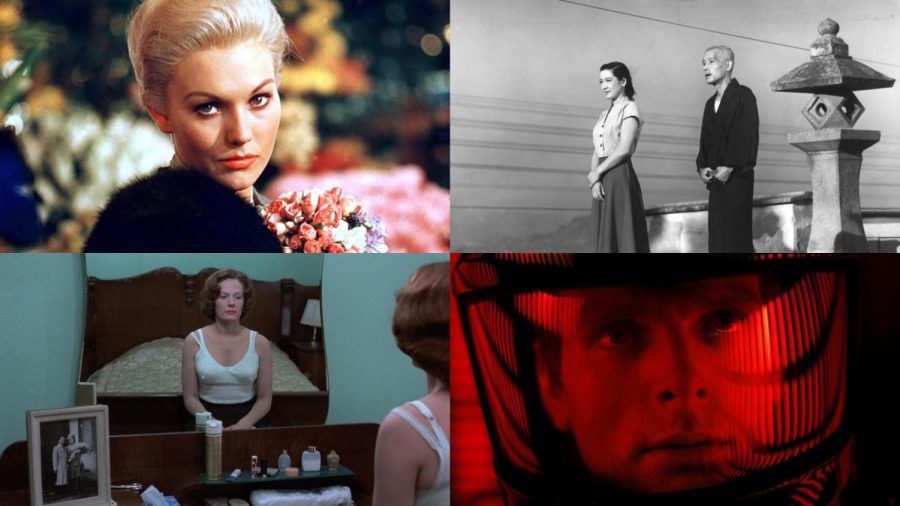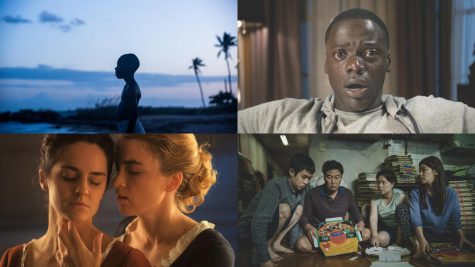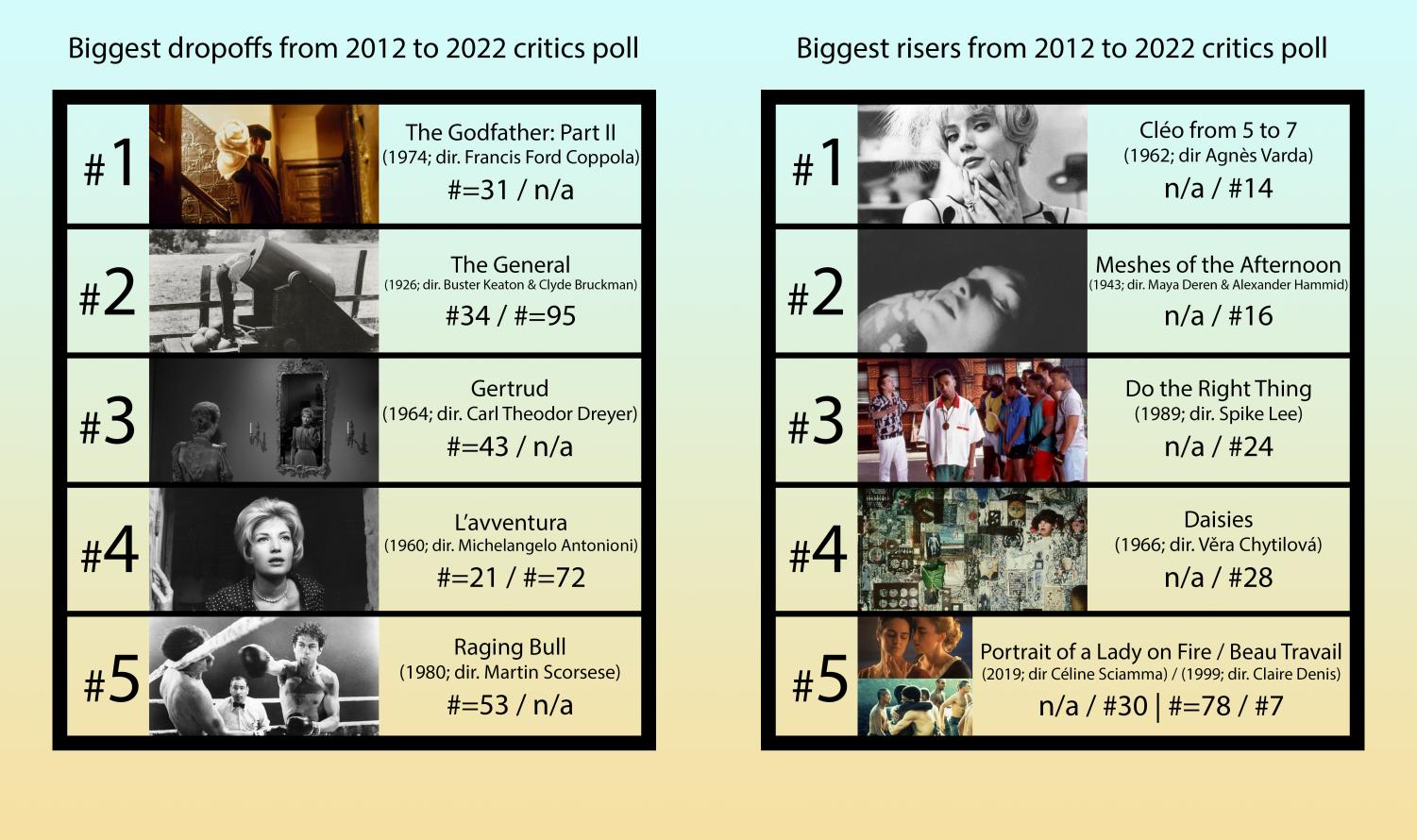An Analysis of the 2022 Sight & Sound Polls
The decennial poll of the greatest films of all time has returned in its eighth edition, with many new changes in store for the largest and most celebrated film canon in the world.
December 13, 2022
In 1952, the British Film Institute-published magazine Sight and Sound invited film professionals from Belgium, Britain, Czechoslovakia, Denmark, France, Germany, Italy, Sweden, the United States and Yugoslavia to list the ten films “that have impressed you most personally,” and from their ballots, an objective canon would be established. The first decennial poll of The Greatest Films of All Time only featured the opinions of 63 critics and was met with some complaints and criticism, but with each subsequent survey, it only continued to grow in both size and stature. Now, it’s become one of the most prestigious and foremost events in the global film community, and in its eighth poll running, it’s never been more popular. This year, 1,639 critics, programmers, curators, archivists and academics and 458 filmmakers—nearly double the number of professionals and a sizable increase in directors from 846 and 358 in 2012—submitted ballots in their respective polls, and for the next ten years, cinephiles have another new, definitive canon of the best films ever made.
The first and most major thing in any ranked list is, of course, what’s at number one. After Alfred Hitchcock’s “Vertigo” toppled “Citizen Kane”’s 50-year-long run in first place in 2012, there were discussions and rumors on social media leading up to the poll’s reveal about whether or not “Kane” would take back the throne or even if a different film altogether would take the top spot. The former did happen with the directors, with Stanley Kubrick’s massively influential sci-fi classic “2001: A Space Odyssey” ascending into the top spot—a whole one position up from its spot below Yasujirō Ozu’s “Tokyo Story” in 2012—but for the critics, it was, in incredibly shocking and shockingly incredible fashion, the latter. The film that critics voted as the greatest of all time this year was none other than Chantal Akerman’s feminist slow cinema masterpiece “Jeanne Dielman, 23, quai du Commerce, 1080 Bruxelles,” making it the fourth film after “Bicycle Thieves,” “Vertigo” and “Citizen Kane” and the first film directed by a woman to ever hold the title in the main list.

“Jeanne Dielman” is one of many films whose placement on the list reflects the ever-growing diversity in the voters—the number of films made by black filmmakers increased from one in 2012 to seven in 2022, and the number of films made by women filmmakers increased from two to eleven—but also, and arguably more importantly, shows how significant the correlation between the availability and quality of a film and its status is. Take Charles Burnett’s “Killer of Sheep” for example, which originally premiered in 1978 but went without an official release for nearly 30 years before receiving a 35mm restoration and (sadly now out-of-print) DVD release in 2007 and now sits at a lofty 43rd alongside Andrei Tarkovsky’s “Stalker” in the critics poll. Or consider the Criterion Collection, which continues to put out new, high-quality DVDs, Blu-rays, and 4K Blu-rays of films from around the world every month and as of right now has released 62 of the 100 films featured in the critics poll, a number that’s likely a lot less coincidental than it may seem. In order for any film to be canonized, it must not only be readily available for those willing to seek it out but also properly restored, especially if it’s an older movie whose original film elements need to be physically preserved—which, seeing as how only 37 of the 134 films featured across both polls are from after 1980, is absolutely crucial.

Another factor in a decennial poll that’s worth looking at is what or if any films made during that ten-year gap manage to make the list. In 2012, there were zero films that had been released since 2002 to make the top 101 in the critics poll, while Paul Thomas Anderson’s 2007 film “There Will Be Blood” and Michael Haneke’s 2005 film “Caché” made the top 106 in the directors poll and even both tied for 75th. This year, the only films that were released after 2012 that managed to snag the coveted spots were Barry Jenkins’ “Moonlight,” Jordan Peele’s “Get Out,” Céline Sciamma’s “Portrait of a Lady on Fire” and Bong Joon-ho’s “Parasite,” with “Moonlight” and “Parasite” being the only two of the four to place in both polls and “Get Out” and “Portrait” both only placing in the critics poll. Aside from the increase in the number of newer films on the list, certainly one of the biggest shocks of the reveal came from “Portrait of a Lady on Fire”’s placement all the way at 30th, while the other three films placed in the latter half of the list, similarly to 2012. There are some complaints that could be made about the inclusions of these recent films—for as much as I love “Portrait,” it’s more than a little insane to see it ranked so highly on the list, especially when not a single film from directors like Terrence Malick or John Ford made the top 100—but all four of them have not only had an immediate impact on the most current era of cinema but stand as terrific and well-made films in their own right.

Another small yet notable change is the first appearance of not only one animated film in a Sight & Sound poll, but two—and what’s more, they were both directed by the same animator, and certainly one who needs no introduction to anyone familiar with the medium. Hayao Miyazaki’s timeless masterworks “Spirited Away” and “My Neighbor Totoro” were both new additions to the critics poll and ranked alongside multiple films in 75th and 72nd respectively. As a victory for Japanese cinema, animation as a whole and just Studio Ghibli on its own—whose many significant works deserve such high recognition and more—it’s a momentous and exciting addition to a list that’s as distinguished as this.
In order to make further observations, I made a spreadsheet featuring the critics and directors lists from 2022 with their listed rankings to see the differences between the two as well as their respective predecessors from 2012. The spreadsheet with the complete lists and analysis data is available to view here, but here are some visualizations of the most major and interesting findings:

Sorting both polls by release date, there are a couple of noticeable similarities between them. The 2010s was the least represented decade in both, with 4 films in the critics and 3 in the directors, and the 1950s, 1960s and 1970s were the three with the most films in both, although in different orders. For critics, there were 20 films each from the 1950s and 1960s, and only 14 from the 1970s, whereas the directors featured 19, 21 and a sizable 23 films from the 1950s, 1960s and 1970s respectively. There were also 7 films from the 1920s and 9 from the 1990s in the critics poll compared to the directors’ 4 and 7.

34 of the 100 films that were present in the critics poll were absent in the directors, while 31 of the 104 films that were present in the directors poll were absent in the critics. The two highest-ranked films in the critics poll that weren’t in the directors, Céline Sciamma’s “Portrait of a Lady on Fire” and Věra Chytilová’s “Daisies,” were both directed by women, and one of the more surprising and personally disappointing placements across both lists would have to be the absence of Elem Klimov’s earth-shattering war film “Come and See” in the critics poll, especially since it’s seen a surge in acclaim and popularity in the years leading up to this poll.

The films that shift in and out of any list are great indicators of change in trends, and in the case of Sight & Sound, there’s a clear growth of interest in films outside of the classic canon—25 films fell off the list from 2012, and 24 new ones took their places. Of course, “The Godfather: Part II”’s absence on the list can also be attributed to the fact that the magazine no longer allows professionals to vote for entire collections or trilogies of films, but that still doesn’t make Agnès Varda’s existential New Wave classic “Cléo from 5 to 7” and Maya Deren’s experimental short “Meshes of the Afternoon”’s leaps all the way into the top 20 any less impressive. The only film that was already on the list to significantly move up in the ranks was Claire Denis’s “Beau Travail,” going from being tied for 78th in 2012 all the way into the top 10 this year. Every film of the top five highest risers on the critics list came from black or female filmmakers, which is also a more than welcome change.

Similarly, the directors exhibited the same trend—35 films present in 2012 were usurped by 33 new ones this year. As if its 35-point leap in the critics poll into 1st wasn’t impressive enough, “Jeanne Dielman, 23, quai du Commerce, 1080 Bruxelles” might have pulled off an even more incredible feat in the directors bracket in placing all the way in the top 5 after not being present at all in 2012, which is as strong a testament to the film’s reputation as ever. Also present in the risers is one of only two short films to make either list, Chris Marker’s ruminative sci-fi gem “La Jetée.”
Other interesting facts:
- The most represented directors across both the critics and directors polls are Ingmar Bergman, Robert Bresson, Francis Ford Coppola, Jean-Luc Godard, Alfred Hitchcock, Stanley Kubrick and Akira Kurosawa; each has four films in total.
- The highest-ranked films in the critics poll to tie with each other are Carl Theodor Dreyer’s “The Passion of Joan of Arc” and Yasujirō Ozu’s “Late Spring” at =21st, and the highest-ranked films in the directors poll to tie with each other are Yasujirō Ozu’s “Tokyo Story” and Chantal Akerman’s “Jeanne Dielman, 23, quai du Commerce, 1080 Bruxelles” at =4th.
- The largest tie that occurred in the critics poll was 6 films at both =78th and =95th, and the largest tie that occurred in the directors poll was a massive 21 films at =72.
- The lowest-ranked film in the critics poll to not tie with any other film for the number of votes was Djibril Diop Mambéty’s “Touki Bouki” at 66th, and the lowest-ranked film in the directors poll to not tie with any other film for the number of votes was Robert Bresson’s “Au Hasard Balthazar” at 37th.
- The only film whose position didn’t change from 2012 to 2022 in the critics poll was Stanley Kubrick’s “2001: A Space Odyssey,” which stayed at 6th, and the only film whose position didn’t change from 2012 to 2022 in the directors poll was Orson Welles’ “Citizen Kane,” which was =2nd in 2012 and 2nd in 2022.
The expanded critic and director lists, as well as each individual top ten ballot of the 2,000+ that were submitted, are set to be released sometime in January of 2023, yet seeing which select few films made it into the highest portion of the ranking is just as exciting, and of course, the anticipation is already brewing for what’s in store for 2032. But there is nothing greater to get out of the 2022 Sight & Sound polls than knowing that people all over the world will now find out about and hopefully be inspired to watch some truly great films, as there’s always something new to discover for any person willing to find it, whether a casual moviegoer or a diehard cinephile.



Jack RS • Dec 13, 2022 at 9:08 am
Where’s Cars 2 on the list????
Jake Panek • Dec 13, 2022 at 9:41 am
It’s at 101.